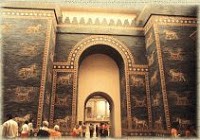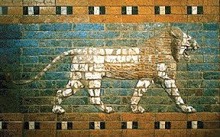Two hundred years ago, scholars doubted whether Babylon ever existed. The only record could be found in the Bible. Critics used the story of Babylon, and what they called its "non-historic kings," to discount Scripture. However, Babylon was discovered and excavated in 1898.
We know today that Babylon was one of the first cities in the world, and founded by Nimrod, great-grandson of Noah (Genesis 10:9-10). Archaeologists have found his name on many inscriptions and tablets, while a massive head of Nimrod has been excavated near Calah on the Tigris River.

A ziggurat.
The Bible tells the story of the tower of Babel and how the language of mankind was confused there. Archaeologists have found that the inhabitants of ancient Mesopotamia had a popular habit of building towers called ziggurats. Almost every city of importance had at least one.
The Tower of Babylon was the highest and largest of all, being 91 meters high and built in seven stages. The foundations and a few steps of the stairway may still be seen today. This was the most probable location of the Tower of Babel. It is interesting to note that, according to the Scriptures, the tower was built of brick and asphalt (Genesis 11:3 NKJV), and this is the very building material found in the buildings of Babylon.

For 1400 years, the city of Babylon grew in importance. In 626 BC, it became the capital of the Babylonian empire. Babylon reached its peak in the time of Nebuchadnezzar II, becoming the wonder of the ancient world. It was 18 kilometers in circumference, with 26-meter-wide double walls towering 62 meters high. It was a magnificent sight, the external brickwork of buildings being glazed and of different colors. The outer walls were yellow, gates were blue, palaces were rose-red, and temples were white with golden domes.
Reliefs of bulls, dragons, and lions decorated many walls and gates. The famous Hanging Gardens were one of the seven wonders of the world. We know today that ancient Babylon was a center of advanced science, art, culture, and industry. Then appeared upon the scene the Hebrew prophets Isaiah and Jeremiah who predicted her utter destruction.
"And Babylon, the glory of kingdoms, the beauty of the Chaldees' excellency, shall be as when God overthrew Sodom and Gomorrah" (Isaiah 13:19).
"And Babylon shall become heaps, a dwelling-place for dragons, and astonishment, and an hissing, without an inhabitant" (Jeremiah 51:37).

These amazing prophecies are all the more astounding because Babylon was located at the very center of economic trade routes of that time. Destruction of a city might have been plausible, but that it would never be rebuilt to be inhabited again seemed far-fetched. This prophetic claim has been tested over the ages, yet the prophecy stands to this very day.
Babylon was extremely wealthy. Jeremiah predicted that these treasures would be robbed, and that all who robbed her would be satisfied (Jeremiah 50:10). To read this history is to read the fulfillment of the prophecy. Cyrus the Median took treasures, Xerxes the Persian took huge amounts of gold, and Alexander of Greece plundered what was left, fulfilling these prophecies to the letter.
Babylon and the Bible